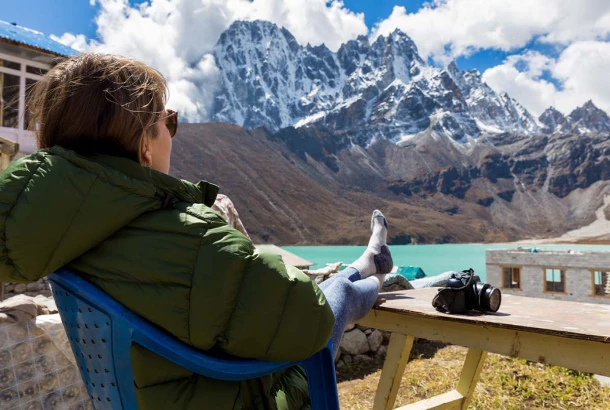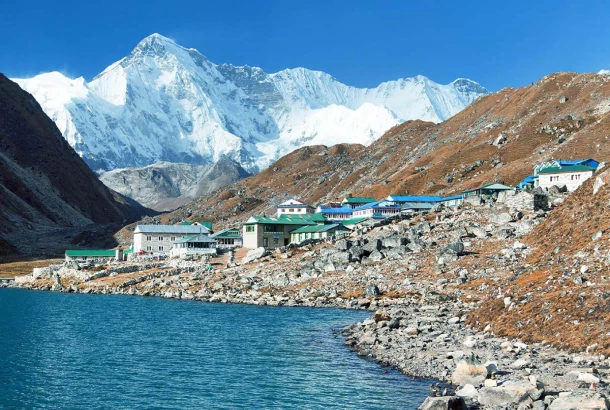Key highlights of Tsum Valley Trekking
- Travel through this seemingly ancient valley off the well-worn path taking in its sights unbothered by mobs of tourists and trappings of modernity.
- Trek across high suspension bridges along roaring waterfalls, travel through dense pine, fir, and oak forests, and observe species endemic to Manaslu region.
- Awe-inspiring views of Himal Chuli (7,893 m), Ganesh Himal (7,422 m), Manaslu (8,163 m), Churke Himal (5,282 m), and Shringi (7161 m).
- Ancient Buddhist monasteries and landmarks are brimming with tales to tell. These landmarks are so important that Tsum Valley is part of Kyimu Lung, a well-known pilgrimage circuit of learning and meditation across the central Trans-Himalaya.
- Historic sites preserved for centuries due to remoteness of valley from time when it was host to its own Kingdom.

Tsum Valley Attractions
Key attractions of Tsum Valley Trekking nature, culture, and people. Let's discussed !
People and Culture
Lying adjacent to Tibet, Tsum Valley molded culturally by Tibetan influence, and many of its inhabitants have migrated from Tibet.
They are named “Tsumba” people, and most of them adhere to Buddhism and speak in dialect different from their neighbors called “Tsumke”.
Buddhist influence is so strong that the valley declared Shagya, meaning Non- sacrificing area. Due to this reason, sacrifice of animals, hunting, honey hunting, and starting forest fires banned in valley since 1920.
Agriculture and tourism are primary sources of income. Most farming is subsistence, with wheat, maize, millet, and potato as major crops.
Local people derive additional income from harvest of Yarchagumba, fungus that grows on larvae of moths and is valuable in Chinese medicine from May to July.
Festivals
Due to stronghold of Buddhism in the region, most festivals celebrated here are religious. Major Festivels Tsum Valley People celebrate:
Lhosar
Lhosar is an important festival in Tsum Valley and Nepal. “Lo” means new, and “sar” means year, so it is a celebration of New Year. All religious buildings in the valley are cleansed and decorated. Family gatherings are organized, where people exchange wishes and gifts for coming year. Enjoy gatherings with traditional foods and homemade alcohol. It falls in January or February.
Saka-Dawa
Saka-Dawa festival to mark Buddha’s birth, death, and enlightenment. This is done by visiting many monasteries of the region. Most devote fast on alternate days. Unique ritual called “Ngyungne” is performed by burning butter lamps.

Flora and Fauna
Covering an altitude ranging from 1905 m to 5093 m., Tsum Valley home to flora ranging from verdant coniferous forests to alpine scrublands.
Forests of oak, rhododendron, and pine grow dense in lower elevation. As you go higher, trees gradually disappear and give way to open grasslands.
Various species of animals call the valley home, with elusive snow leopard, musk deer, Ghoral, Himalayan Thar, and blue sheep being only some of them.
Beautiful visage of birds like Danphe, Monal, Golden eagle, and Himalayan griffon adds vivid colors to outdoors and offers you their melodious songs on your trek.

Monasteries and Caves in Tsum Valley
Tsum Valley is rich in Buddhist tradition and culture. Crucial monasteries are:
Milarepa Cave
Milarepa cave, known as Piren Phu (literally “Pigeon cave”), is considered one of the most sacred sites in valley by its inhabitants.
The cave earned its sanctity and name by being one of landmarks where renowned and influential Tibetan yogi and spiritual poet Milarepa mediated.
Milarepa is an important figure in Tibetan Buddhism, particularly the Kagyu branch, founded by his academic lineage. He said, achieved enlightenment by meditating in many rocky caves such as this one.
The cave is close to Burji village, at bottom of a rugged cliff. Three Gompas are built in vicinity of the cave. Gompas are home to various relics attributed to him, including his footprint.
Serang Gumba
Serang Gumba is an ancient monastery built near a much more ancient cave.
This Gompa is peculiar in Tsum Valley Trekking as it blends Buddhist and Hindu practices at a level uncommon to the region.
The reason for this fusion level is that cave was once. Where Hindu monk Sringi meditated in his quest for peace and enlightenment.
Buddhist paintings and statues line the ancient cave, and you have great time exploring and admiring.
Rachen Gompa
Rachen Gompa, more specifically Rachen Nunnery, is a revered Gompa of Tsum Valley. It lies close to Milarepa Cave, and most itineraries of Tsum Valley Trek contain an overnight in surrounding settlement.
Tsum Valley declared Shagya (literally “Non-sacrificing area”). Inhabitants and visitors must abide by rules around non-violence toward animals. Breaking any of these rules is considered a sin, and punishment is to light 1000 lamps in Rachen Gompa.
Nunnery houses Tibetan doctor who provides medical care to nuns and locals. As nunnery, it includes calm and peaceful atmosphere. Visitors must be mindful while taking in pieces of Buddhist art nunnery features.
Mu Gompa
Mu Gompa is renowned monastery in Tsum Valley, largest one. The Mu Gompa was built in 1936 by Drupa Rinpoche, monk from Bhutan.
It is built atop remote hill with perfect view of towering Himalayas behind. Due to its geography, neighboring settlements are quite a few hours away on foot, isolating the monastery.
Gompa is home of 20 monks, with oldest being here for over 40 years. They live for, studying Buddhist philosophies and practicing their religion.
Most trekkers spend a day of trekking visiting Gompa and trekking base of Pika Himal (4,865 m).

Tsum Valley Trekking Best Season
Autumn (September – November) generally considered best season for trekking in Nepal, and Tsum Valley follows this trend.
Countryside is swept clean by monsoon, giving your trail brand-new vibe. Temperatures hover around the pleasant, giving you best experience while hiking.
Spring (March-May) sees flowers bloom again the following winter and rhododendrons color entire hills red underneath clear blue skies. As with autumn, temperatures are perfect for trekking.
Tsum Valley Trekking Permit Cost
To begin your Tsum Valley Trekking, you must purchase Tsum Valley restricted area Trekking permit. Its cost per person is: -
September – November and March - May
- USD 40 for one week
- USD 7 every day after first week
December – February
- USD 30 for one week
- USD 7 every day after first week
Note that Government of Nepal has made it compulsory to hire trekking guide during your Tsum Valley Trekking.

Tsum Valley Trekking Cost
Cost is around USD 900-1200 but determined by your service including! generally, Tsum Valley Trek Cost includes your meal, accommodation, transport, and Tsum special permits with Manaslu Conservation Area.
Tsum Valley Trekking Itinerary (Updated)
1: Arrive at Kathmandu airport (1300 m)
2: Drive from Kathmandu to Machhe Khola (869 m), Driving Duration: 8-9 hours
3: Trek from Machha Khola to Jagat (1340 m), Trek Duration: 6-7 hours
4: Jagat to Chisopani (1660 m), Trek Duration: 4 to 5 hours
5: Chisopani to Chumling (2386 m), Trek Duration: 6 to 7 hours
6: Chumling to Chhokang Paro (3031 m), Trek Duration: 4 to 5 hours
7: Chhakam Paro to Nile (3361 m), Trek Duration: 5 to 6 hours
8: Hike 1: 30 Hours and explore Mu Gompa and trek to Chhakam Paro
9: Chhakam Paro to Burgi Village (2386 m), Trek Duration: 5 hours
10: Burgi village to Chumling (2386 m), Trek Duration: 5 to 6 hours
11: Chumling to Philim (1570 m), Trek Duration: 6 to 7 hours
12: Trek from Philim to Khorlabesi (970 m), Trek Duration: 6 to 7 hours
13: Trek from Khorlabesi to Machhe Khola, Trek Duration: 3 to 4 hours
14: Drive from Machhe Khola to Kathmandu, Drive Duration: 8 to 9 hours
15: Ace Vision Treks Transfer to the international airport for your final flight departure
Let us know your Vacation limits and we suggest best itinerary and package for you. Orderany trekking itinerary vs tailor-made.
Tsum Valley Trek Booking Benifits with Ace Vision Treks
- Local expertise of Manaslu Tsum regions
- Customize-trips per travelers vacation limits
- Tailor-made trek itinerary
- Sleeping bag, Dawn jacket, duffle bag (trekking gear) provided
- Online secure payment system
- High Qulity services
- Flexibility for itinerary, personal interest
- We value your journey in off-beaten-path
Finally,
Tsum Valley Trekking organized by local Tour Trekking Company in Nepal guarantees safe journey first and foremost, and all that with best prices, you find among establishments peddling packages.
Ace Vision Treks handle all hassle free of paperwork to encounter. Our experience guide sharing truth about Tsum Valley and reality. Your Journy is valued and worth of vacation while you hike Tsum valley. So, take step into this magical and ancient land with us!
Informative Travel Blogs
Trekking in Nepal - A Complete Travel Guide
Trekking Packages in Nepal










